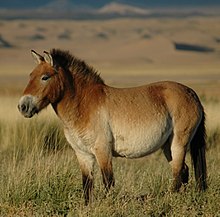Equinae

| Equinae Temporal range: | |
|---|---|
 | |
| Przewalski's horse | |
| Scientific classification | |
| Domain: | Eukaryota |
| Kingdom: | Animalia |
| Phylum: | Chordata |
| Class: | Mammalia |
| Order: | Perissodactyla |
| Family: | Equidae |
| Subfamily: | Equinae Steinmann & Döderlein 1890 |
| Tribes | |
Equinae is a subfamily of the family Equidae, known from the Hemingfordian stage of the Early Miocene (16 million years ago) onwards.[1][2] They originated in North America, before dispersing to every continent except Australia and Antarctica. They are thought to be a monophyletic grouping.[3] Members of the subfamily are referred to as equines;[4] the only extant equines are the horses, asses, and zebras of the genus Equus, with two other genera Haringtonhippus and Hippidion becoming extinct at the beginning of the Holocene, around 11–12,000 years ago.
The subfamily contains two tribes, the Equini and the Hipparionini, as well as two unplaced genera, Merychippus and Scaphohippus. Members of the family ancestrally had three toes, while members of the tribe Equini from the Middle Miocene onwards developed monodactyl feet.[5]
Sister taxa
[edit]References
[edit]- ^ "Paleobiology Database: Equinae basic info". Archived from the original on 2009-06-21. Retrieved 2009-08-03.
- ^ Cantalapiedra, Juan L.; Prado, Jose Luis L.; Hernández Fernández, Manuel; Alberdi, Mª Teresa (10 February 2017). "Decoupled ecomorphological evolution and diversification in Neogene-Quaternary horses". Science. 355 (6325): 627–630. Bibcode:2017Sci...355..627C. doi:10.1126/science.aag1772. PMID 28183978. Retrieved 13 February 2019 – via Escience.magazine.org.
- ^ B. J. MacFadden. 1998. Equidae. In C. M. Janis, K. M. Scott, and L. L. Jacobs (eds.), Evolution of Tertiary Mammals of North America
- ^ Cantalapiedra, Juan L.; Sanisdro, Oscar L.; Cantero, Enrique; Prado, Jose Luis; Alberdi, Mª Teresa Luis (4 August 2023). "Evolutionary Radiation of Equids". In Prins, Herbert H.; Gordon, Ian J. (eds.). The Equids, A Suite of Splendid Species. Fascinating Life Sciences. Springer. pp. 27–45. doi:10.1007/978-3-031-27144-1_2. ISBN 978-3-031-27143-4 – via www.springer.com.
- ^ Janis, Christine M.; Bernor, Raymond L. (2019-04-12). "The Evolution of Equid Monodactyly: A Review Including a New Hypothesis". Frontiers in Ecology and Evolution. 7. doi:10.3389/fevo.2019.00119. hdl:1983/ede09e37-96f7-4baf-aec5-1bb7766a04e7. ISSN 2296-701X.